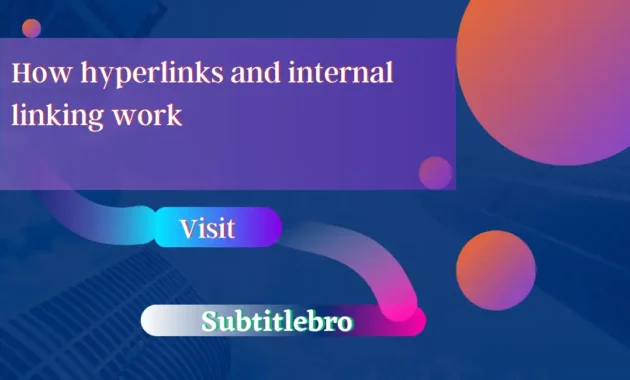Every time you post a new article on your blog, you’re adding links to other articles on your site. While linking to other articles is an important part of providing readers with context and information, it’s also important to make sure that all the links you add are actually useful and relevant.
In this article, we’ll discuss the different types of links and how to properly use them so that your site looks professional and authoritative.
Hyperlinks are one of the most important aspects of SEO. When you hyperlink to another website, it tells search engines that you think your content is worth visiting and that you’re confident enough in it to share it with others. But what if you make a mistake and link to the wrong website? Internal linking is the solution to that problem!
Internal linking is a powerful way to improve the readability and accessibility of your content. When you link to other pages on your website or blog, you’re indicating to your readers that they should explore those pages for more information.
What is a Hyperlink?
Hyperlinks are the blue underline that you see on most websites. They allow you to link to other websites or pages on your own website. Hyperlinks also allow you to easily jump from one page on your website to another.
When you create a hyperlink, WordPress will automatically add the “HTTP://” portion of the URL before the hyperlink text. For example, if you were linking to a post called “How to Make an Awesome Pumpkin Pie,” your hyperlink would look like this:
http://www.thespruceeats.com/how-to-make-an-awesome-pumpkin-pie-4056434
How do Hyperlinks Work?
Hyperlinks are used to connect one document or webpage to another. Hyperlinks can either be external (outside of the website) or internal (within the website).
When a hyperlink is clicked, it takes the user to the linked page or document. Hyperlinks are also used to highlight important sections of a website for users who are looking for specific information.
Creating hyperlinks is simple: just type any text that you want to link to in your web document, and then surround it with the “link” symbol (a straight line with a left-pointing arrowhead at one end and a right-pointing arrowhead at the other).
Hyperlinks are a great way to connect different parts of your site. When you click on a hyperlink, your browser will take you to the page that the hyperlink points to. Hyperlinks can also be used to link to other pages within your site. Hyperlinks are also used to link to external websites.
What are the Different Types of Hyperlinks?
Hyperlinks can be classified into three categories: external, internal, and cross-reference.
External hyperlinks: These links point to other websites or documents outside of the blog post or website. The most common type of external link is a link to an article on another website.
Internal hyperlinks: These links point to other parts of the same blog post or website. They are used to organize and structure the content of a blog post.
Cross-reference hyperlinks: These links point to related information in other parts of the same website or blog post. They help readers find specific information more easily.
Each type of hyperlink has its own advantages and disadvantages.
External hyperlinks are the most common type of hyperlink. They are easy to create and manage, and they allow readers to explore different parts of a website or blog post. However, external links can be lost over time, and they can be difficult to track down.
Internal hyperlinks are useful for organizing and structuring a blog post’s content. They are less commonly used than external links, but they provide more context for readers.
Cross-reference hyperlinks are the most powerful type of hyperlink. They help readers find related information more easily, and they can be helpful when creating searchable content. However, cross-reference links can be difficult to create and manage, and they can clutter a blog post’s layout.
How to Add Hyperlinks in an HTML Document

When you want to add hyperlinks in an HTML document, there are a few different things that you can do.
One way is to use the tag. To make a link to a specific page in your document, you would use the following code:
To create a link to a particular section of your document, you would use the following code:
My SectionYou can also create a link to a file by using the following code:
File Name
Finally, you can create a link to another page on the internet by using the following code:
URL
How to Remove Hyperlinks from a Document
Hyperlinks can be a great way to connect different sections of a document, but over time they can get in the way. Hyperlinks can also lead to unintended web pages when documents are shared. In this article, we will discuss how to remove hyperlinks from a document.
If you want to remove all hyperlinks from a document, you can use the “Remove Links” tool in Microsoft Word 2010. To access this tool, go to the Home tab of the ribbon and click on the “Remove Links” button. When the “Remove Links” window appears, select the hyperlinks that you want to remove and click on the “Delete” button.